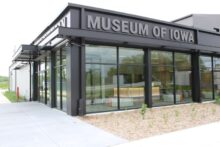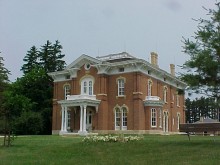Each year, Silos & Smokestacks National Heritage Area (SSNHA) celebrates the best in heritage development by presenting the “People’s Choice Site of the Year”. Voted on by the public, this special honor is presented to only one deserving SSNHA Partner Site.
Voting for the 2025 Site of the Year will be open to the public at www.silosandsmokestacks.org from Oct. 27-31. The top three finalists as of Nov. 4 will be invited as our guests to the Heritage Area Annual Training on Nov. 6, where the winner will be announced and receive the traveling award for People’s Choice “Site of the Year.”
Check back for link to vote!
 |
The African American Museum of Iowa is one of a limited number of museums in Iowa that educate the public about the history of African Americans and their experiences living in the heartland of the United States. Having recently undergone major renovation, they are now able to reach more people, including the younger generation. As we continue to live though such uncertain times, institutions such as this one are imperative when it comes to keeping the history and rights of minorities at the forefront of our minds. They help preserve this history for future generations to learn from.
|
 |
Connecting! That’s the Kinney Pioneer Museum philosophy. Connecting with our visitors while showcasing agriculture, the sugar beet industry, blacksmithing, broom making, the Jefferson Highway, the brick and tile industry, KGLO radio, home and family life, the Kinney Pioneer Museum celebrates and embraces all facets of the history of North Iowa.
In the late 1960s a group of citizens partnered with the Kinney Lindstrom Foundation to build a museum to display and build on a community collection of North Iowa artifacts. That collection and one building has grown to two additions to the building, four historical buildings and two additional buildings for display of agricultural implements. Opening our doors and connecting even farther into the community the museum is taking outreach out to civic groups, assisted living and LifeLong Learning. We have received a generous donation of picnic tables and benches to continue to make the museum experience welcoming for school groups, adult day care field trips, assisted living outings and civic groups. Local professionals demonstrate the antique printing presses, agriculture implements, blacksmithing, apple cider pressing and the roller rink calliope. Professionals and collecting enthusiasts assist with our tractor ride, tractor and car show, apple cider day and “Meet our History.” And did you know that John Kopecky started the North Iowa Band Festival? We can connect you to that too! |
 |
The Matthew Edel Blacksmith Shop provides a close-up view to the intersection of agricultural and industrial history in small-town Iowa. Born in 1856, Matthew Edel was a German immigrant who came to Iowa with his family when he was 14. He showed a talent for tinkering and inventing; today we might call him a “maker”. By the age of 27, he had moved to Haverhill where he purchased a lot and established a blacksmith shop. That shop, along with the Edel family, grew over time and became intertwined with the surrounding area.
Matthew Edel was an extraordinary small-town blacksmith. He was inventive in creating machines and tools; he was ingenious in setting up his shop to operate efficiently; he was a businessman who made a living adequate to support his large family, and he was also an artist who designed beautiful iron cemetery crosses. The shop shows the family’s talents as farriers, wheelwrights, farm-implement maintainers, and automobile mechanics. Today it’s rare to find such a complete and original shop open to visitors, kept just as Matthew Edel left it before he died. See his tools, inventions, and hear stories about blacksmithing in the age before tractors and automobiles. In addition to the shop, visitors can also see the automobile garage, the Edel family house, and a summer kitchen. A new series of interpretive panels take a deeper dive into Matthew Edel and his work, immigration to Iowa, and Iowa life in the 1920’s and 1930’s. |
 |
Montauk Historic Site is the Gilded-Age home of William Larrabee, Iowa’s 12th Governor, and his family. Visitors see how the Larrabee family lived on this rural estate from 1874 to 1965 which still contains unique and original furnishings.
Originally from Connecticut, in 1853 Larrabee came west to follow opportunity and settled in Clermont. Showing an aptitude for business, he eventually became one of Iowa’s largest landowners. A career in politics followed, and he served as a state senator for 18 years. He was elected twice as governor, serving from 1886 to 1890 and was the first governor to occupy the newly-built State House in Des Moines. Built in 1874, Montauk reflects the wealth and lofty status of its occupants. The Larrabee family traveled widely and decorated their home with souvenirs from around the world. Visitors will see Tiffany lamps, Wedgewood china, Italian statues, Swiss music boxes, a large collection of paintings, and thousands of books. The property was also a working farm with barns, farm animals, an orchard, and grain fields. Music was important to the Larrabee family, and this is reflected in the site’s programming. The “Music at Montauk” series and Winter concerts in the parlor showcase local and regional artists and bring the house alive. Likewise, the historic Kimball pipe organ at Montauk’s Union Sunday School building is the focus of an organ concert series. In later parts of the year, Montauk plays host to a Fall Festival and a Holiday open house. |
 |
Plum Grove Historic Home is the retirement home of Robert Lucas, first governor of the Iowa Territory, and his family. Once the centerpiece of a large farm, it is now nestled in a pleasant Iowa City neighborhood making it easily accessible to Iowans and visitors from around the country. The site is filled with period-appropriate objects and engages visitors through tours and programs like ‘Games in the Grove’ and ‘Plum Spooky’. Next year new exterior interpretive panels will help visitors understand what archaeology has revealed about the evolution of Plum Grove from its construction in 1845 through today. |



